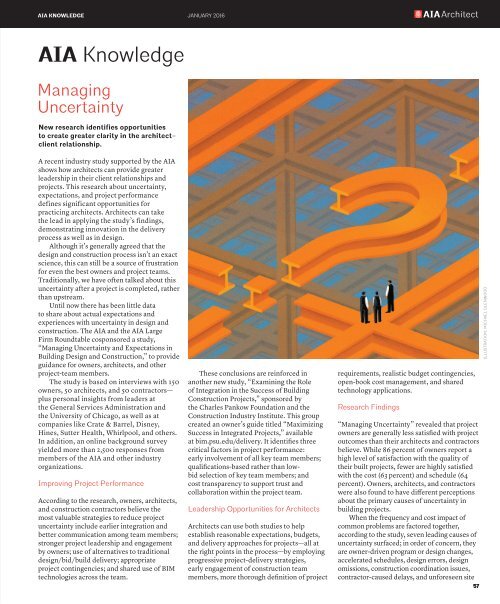Architect 2016-01
Create successful ePaper yourself
Turn your PDF publications into a flip-book with our unique Google optimized e-Paper software.
AIA SECTION KNOWLEDGE TITLE JUNE JANUARY 2<strong>01</strong>5<strong>2<strong>01</strong>6</strong> AIA <strong>Architect</strong><br />
AIA Knowledge<br />
Managing<br />
Uncertainty<br />
New research identifies opportunities<br />
to create greater clarity in the architect–<br />
client relationship.<br />
A recent industry study supported by the AIA<br />
shows how architects can provide greater<br />
leadership in their client relationships and<br />
projects. This research about uncertainty,<br />
expectations, and project performance<br />
defines significant opportunities for<br />
practicing architects. <strong>Architect</strong>s can take<br />
the lead in applying the study’s findings,<br />
demonstrating innovation in the delivery<br />
process as well as in design.<br />
Although it’s generally agreed that the<br />
design and construction process isn’t an exact<br />
science, this can still be a source of frustration<br />
for even the best owners and project teams.<br />
Traditionally, we have often talked about this<br />
uncertainty after a project is completed, rather<br />
than upstream.<br />
Until now there has been little data<br />
to share about actual expectations and<br />
experiences with uncertainty in design and<br />
construction. The AIA and the AIA Large<br />
Firm Roundtable cosponsored a study,<br />
“Managing Uncertainty and Expectations in<br />
Building Design and Construction,” to provide<br />
guidance for owners, architects, and other<br />
project-team members.<br />
The study is based on interviews with 150<br />
owners, 50 architects, and 50 contractors—<br />
plus personal insights from leaders at<br />
the General Services Administration and<br />
the University of Chicago, as well as at<br />
companies like Crate & Barrel, Disney,<br />
Hines, Sutter Health, Whirlpool, and others.<br />
In addition, an online background survey<br />
yielded more than 2,500 responses from<br />
members of the AIA and other industry<br />
organizations.<br />
Improving Project Performance<br />
According to the research, owners, architects,<br />
and construction contractors believe the<br />
most valuable strategies to reduce project<br />
uncertainty include earlier integration and<br />
better communication among team members;<br />
stronger project leadership and engagement<br />
by owners; use of alternatives to traditional<br />
design/bid/build delivery; appropriate<br />
project contingencies; and shared use of BIM<br />
technologies across the team.<br />
These conclusions are reinforced in<br />
another new study, “Examining the Role<br />
of Integration in the Success of Building<br />
Construction Projects,” sponsored by<br />
the Charles Pankow Foundation and the<br />
Construction Industry Institute. This group<br />
created an owner’s guide titled “Maximizing<br />
Success in Integrated Projects,” available<br />
at bim.psu.edu/delivery. It identifies three<br />
critical factors in project performance:<br />
early involvement of all key team members;<br />
qualifications-based rather than lowbid<br />
selection of key team members; and<br />
cost transparency to support trust and<br />
collaboration within the project team.<br />
Leadership Opportunities for <strong>Architect</strong>s<br />
<strong>Architect</strong>s can use both studies to help<br />
establish reasonable expectations, budgets,<br />
and delivery approaches for projects—all at<br />
the right points in the process—by employing<br />
progressive project-delivery strategies,<br />
early engagement of construction team<br />
members, more thorough definition of project<br />
requirements, realistic budget contingencies,<br />
open-book cost management, and shared<br />
technology applications.<br />
Research Findings<br />
“Managing Uncertainty” revealed that project<br />
owners are generally less satisfied with project<br />
outcomes than their architects and contractors<br />
believe. While 86 percent of owners report a<br />
high level of satisfaction with the quality of<br />
their built projects, fewer are highly satisfied<br />
with the cost (63 percent) and schedule (64<br />
percent). Owners, architects, and contractors<br />
were also found to have different perceptions<br />
about the primary causes of uncertainty in<br />
building projects.<br />
When the frequency and cost impact of<br />
common problems are factored together,<br />
according to the study, seven leading causes of<br />
uncertainty surfaced; in order of concern, they<br />
are owner-driven program or design changes,<br />
accelerated schedules, design errors, design<br />
omissions, construction coordination issues,<br />
contractor-caused delays, and unforeseen site<br />
57<br />
ILLUSTRATION: MICHAEL GLENWOOD

















